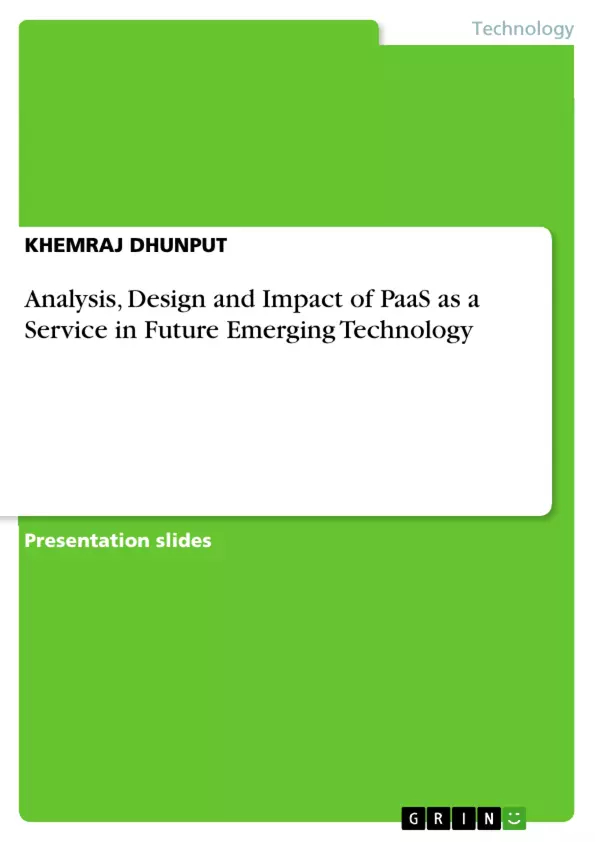This paper is about PaaS as a Service in Future Emerging Technology. Cloud computing is becoming one of the most popular emerging technology being discussed in today’s technology world. It was built when application and services were moved to the cloud and it has its origin in network diagrams that represents the internet and is a gradually developing model. The National Institute of Standards [NIST] defines cloud computing as a highly demand network access to a collection of shared resources which can be provided very quickly with lower management effort.
PaaS is a platform which is being used by the developers to build software must faster and deploying as a SaaS application to end users. PaaS is used to develop Web and mobile applications using a wide array of components, ranging from programming languages and application servers to message queues and databases.
Inhaltsverzeichnis (Table of Contents)
- Definition of cloud computing
- Architectural layers of cloud computing
- Public cloud computing
- Private Cloud
- Hybrid Clouds
- Technical side of PaaS
Zielsetzung und Themenschwerpunkte (Objectives and Key Themes)
This text examines the concept of Platform as a Service (PaaS) within the context of cloud computing, exploring its advantages and drawbacks. It aims to provide an understanding of how PaaS can be used to develop and deploy software applications more efficiently.
- Definition and characteristics of cloud computing
- Architectural layers of cloud computing
- Different types of cloud infrastructure models: public, private, and hybrid
- The role of PaaS in software development and deployment
- Benefits and challenges associated with PaaS adoption
Zusammenfassung der Kapitel (Chapter Summaries)
- Definition of cloud computing: This section introduces the concept of cloud computing, defining it as a model for delivering computing services—including servers, storage, databases, networking, software, analytics, and intelligence—over the internet. It highlights the key characteristics and advantages of cloud computing, such as reduced costs, increased flexibility, and scalability.
- Architectural layers of cloud computing: This section explores the different layers of cloud computing architecture, focusing on the three main infrastructure models: public, private, and hybrid clouds. It provides an overview of the characteristics and use cases for each model.
- Public cloud computing: This section details the features of public cloud computing, highlighting its advantages for businesses, such as cost reduction and reduced risk. It also discusses the potential challenges associated with public cloud deployment, such as security concerns.
- Private Cloud: This section explores private cloud computing, focusing on its advantages for businesses that require greater control over data and security. It explains how private clouds can be implemented and the potential benefits of this approach.
- Hybrid Clouds: This section examines hybrid cloud computing, highlighting its ability to combine the advantages of both public and private cloud models. It discusses the benefits of hybrid cloud deployment, such as increased flexibility and scalability, and the potential challenges of implementing this approach.
- Technical side of PaaS: This section provides a detailed overview of PaaS, explaining how it can be used by developers to build and deploy software applications more efficiently. It highlights the various components and features of PaaS platforms, such as programming languages, application servers, and databases.
Schlüsselwörter (Keywords)
The text focuses on cloud computing, platform as a service (PaaS), cloud infrastructure models (public, private, hybrid), software development, deployment, benefits, and challenges.
- Arbeit zitieren
- KHEMRAJ DHUNPUT (Autor:in), 2019, Analysis, Design and Impact of PaaS as a Service in Future Emerging Technology, München, GRIN Verlag, https://www.hausarbeiten.de/document/500595


